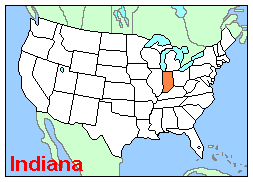America's Volcanic Past -
Indiana
| "Though few people in the United States may actually experience an erupting volcano, the evidence for earlier volcanism is preserved in many rocks of North America. Features seen in volcanic rocks only hours old are also present in ancient volcanic rocks, both at the surface and buried beneath younger deposits." -- Excerpt from: Brantley, 1994 |

Volcanic Highlights and Features:
[This list is just a sample of
various Indiana volcanic features or events and is by no means inclusive.]
- Indiana
- Indiana Regions
- Indiana - Brief Geologic History
- Indiana's Volcanic Rocks
- Glacial Erratics
- Volcanic Ash Deposits
Indiana is a large anticline that plunges to the northwest. Consequently, the age and type of rocks in Indiana are governed by this large structural feature. The youngest rocks are in the northeastern and southwestern corners of the state, and the oldest are in the southeastern corner. The oldest rocks are primarily limestone, dolostones, and shales, whereas the youngest rocks are mostly sandstones and shales with minor amounts of limestone and coal. The distribution of rock types is the major control on the physiographic provinces in the southcentral part of the state.
Indiana's Rocks:
Excerpts from: Indiana Geological Survey Website, 2001 |
||
The Interior Plains:3
|
||
Indiana's "Basement"2
Precambrian History:1
North American Craton:2
|
||||
| Indiana's Volcanic Rocks |
Volcanic Rocks are Beneath the Surface:2
Rocks a billion or more years old lie
deeply buried beneath the surface of Indiana.
Because younger rocks rest on
them, geologists call these rocks the Basement.
Only about 20 drill holes in Indiana
have reached these rocks. From these
holes and from seismic soundings
geologists have gotten a glimpse of
the geologic history representing
most of the time that has elapsed since the earth
was formed. And they have learned
that the Basement is only about 3,000 feet
below the surface in east-central
Indiana, more than 2 miles deep in southwestern Indiana.
Samples of granite, basalt, and
marble from the deep holes differ
greatly from the sedimentary bedrock on which we
live and from which we get most
of our mineral resources.
Knowledge
of these rocks is important because similar
rocks elsewhere contain rich
mineral deposits. And their position
in some places in Indiana controls the structure of
overlying rocks that may contain gas and oil.
Indiana's Tioga Bentonite:2
Just as Mount St. Helens recently
covered some western states with volcanic ash,
a volcano covered Indiana with ash long ago.
About 380 million years ago,
violent volcanic eruptions in what is now central
Virginia threw a great amount of ash into the air.
This ash covered much of the present eastern United
States. Near the vents, ash beds are about 200 feet thick.
The beds decrease in thickness westward, and
only a bed a few inches thick marks the event in Indiana.
This ash bed, deposited in the Middle Devonian
Period, is the Tioga Bentonite.
The Tioga Bentonite can be distinguished
from the surrounding rocks, and it can be
traced on geophysical well logs throughout
the eastern United States. Analysis shows the
presence of the clay mineral potassium
bentonite, along with angular quartz fragments
and well-formed crystals of feldspar, mica, and zircon,
which had begun to form deep in the earth
before the ancient eruption.
| Glacial Erratics |
Glacial Erratics:2
Erratics are water- and ice-worn rocks
transported from distant sources by glacial ice.
They are made up of rock types different from the bedrock.
Glacial drift of northern Indiana
contains tons of cobbles and boulders of granite,
gneiss, marble, quartzite, basalt,
and other rocks.
Many stream valleys
contain minute traces of gold, diamonds,
quartz, garnet, and other unusual minerals.
Erratics are generally considered to be a nuisance,
especially by farmers who must clear
their fields of rocks that frost
forces to the surface.
But some gravel pit operators have
found a ready market for "fieldstone"
cobbles and larger
erratic boulders for architectural and
specialty construction.
| Volcanic Ash Deposits |
Volcanic Ash Deposits in Indiana:2
Just as Mount St. Helens recently
covered some western states with volcanic ash,
a volcano covered Indiana with ash long ago.
About 380 million years ago,
violent volcanic eruptions in what is now central
Virginia threw a great amount of ash into the air.
This ash covered much of the present eastern United
States. Near the vents, ash beds are about 200 feet thick.
The beds decrease in thickness westward, and
only a bed a few inches thick marks the event in Indiana.
This ash bed, deposited in the Middle Devonian
Period, is the Tioga Bentonite.
The Tioga Bentonite can be distinguished
from the surrounding rocks, and it can be
traced on geophysical well logs throughout
the eastern United States. Analysis shows the
presence of the clay mineral potassium
bentonite, along with angular quartz fragments
and well-formed crystals of feldspar, mica, and zircon,
which had begun to form deep in the earth
before the ancient eruption.
Excerpts from:
1) Michael C. Hansen, The Geology of Ohio -- The Precambrian,
GeoFacts No. 13,
Ohio Department of Natural Resources, Division of Geological Survey,
Ohio Geological Survey Website, July 2001
2) Indiana Geological Survey Website, 2001, 2002
3) USGS/NPS Geology in the Parks Website, August 2001
[Return to
America's Volcanic Past - States and Regions]
[Return to
America's Volcanic Past - National Parks and Monuments]
[Return to
Visit A Volcano Menu]


